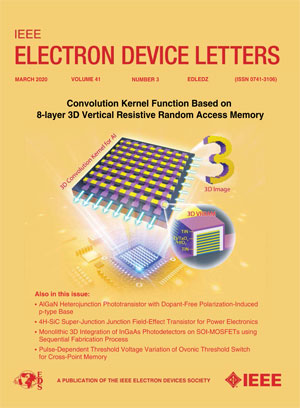增强低温Al-Al键合的成本效益3D集成
IF 4.5
2区 工程技术
Q2 ENGINEERING, ELECTRICAL & ELECTRONIC
引用次数: 0
摘要
Al-Al键合被认为是直接金属键合应用的一种有前途的替代方案,它提供了低成本的细间距互连,并且具有最小的额外工艺和复杂性。传统的Al-Al热压键合需要高温($\gt 300~^{\circ }$ C)和高压来克服表面氧化层,这限制了其工艺兼容性和在先进封装中的潜在应用。这项工作提出了一种利用Au钝化层的低温Al-Al键合方法,在$160\sim 250~^{\circ }$℃下以2 MPa的结合力实现了高度可靠的互连。Ti/Au金属堆钝化能有效抑制Al表面氧化。在键合过程中,Al原子通过Ti晶界扩散到键合界面,形成了低孔隙率的高强度接头。力学试验表明,粘结界面的平均抗剪强度为40.85 MPa。电特性显示接触电阻率为$0.93\sim 2.0\times 10^{-7} ~\Omega \cdot $ cm2,与传统的高温Al-Al键合相当。进一步的微观分析阐明了Al-Au在键合过程中相互扩散和界面金属间化合物形成的机理。该技术为3D集成提供了一种低温且经济高效的解决方案。本文章由计算机程序翻译,如有差异,请以英文原文为准。
Enhancement of Low-Temperature Al-Al Bonding for Cost-Effective 3D Integration
Al-Al bonding is considered as a promising alternative for direct metal bonding applications providing low-cost fine-pitch interconnections with minimum additional process effort and complexity. Conventional Al-Al thermocompression bonding requires high temperature ( $\gt 300~^{\circ }$ C) and elevated pressure to overcome surface oxide layers, which limits its process compatibility and potential applications in advanced packaging. This work proposes a low-temperature Al-Al bonding method utilizing an Au passivation layer, achieving highly reliable interconnections at $160\sim 250~^{\circ }$ C with 2 MPa bonding force. The Ti/Au metallic stack passivation effectively suppresses Al surface oxidation. During bonding process, Al atoms diffuse through Ti grain boundaries to the bonding interface, forming a high-strength joint with low porosity. Mechanical tests demonstrate an average shear strength of 40.85 MPa at the bonded interface. Electrical characterization reveals a contact resistivity of $0.93\sim 2.0\times 10^{-7} ~\Omega \cdot $ cm2, comparable to conventional high-temperature Al-Al bonding. Further microscopic analysis elucidates the mechanisms of Al-Au interdiffusion and interfacial intermetallic compound formation during bonding. This technique offers a low-temperature and cost-effective solution for 3D integration.
求助全文
通过发布文献求助,成功后即可免费获取论文全文。
去求助
来源期刊

IEEE Electron Device Letters
工程技术-工程:电子与电气
CiteScore
8.20
自引率
10.20%
发文量
551
审稿时长
1.4 months
期刊介绍:
IEEE Electron Device Letters publishes original and significant contributions relating to the theory, modeling, design, performance and reliability of electron and ion integrated circuit devices and interconnects, involving insulators, metals, organic materials, micro-plasmas, semiconductors, quantum-effect structures, vacuum devices, and emerging materials with applications in bioelectronics, biomedical electronics, computation, communications, displays, microelectromechanics, imaging, micro-actuators, nanoelectronics, optoelectronics, photovoltaics, power ICs and micro-sensors.
 求助内容:
求助内容: 应助结果提醒方式:
应助结果提醒方式:


